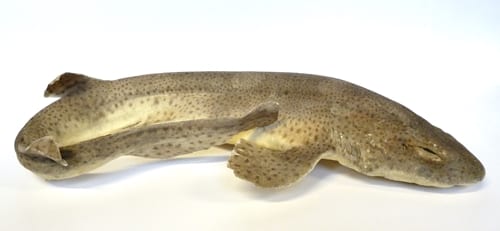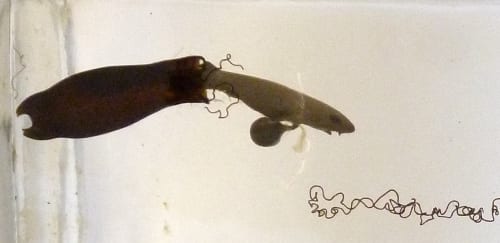Specimen of the week 269: the dogfish
By Will J Richard, on 9 December 2016
Hello people of the internet. Will Richard here blogging away about a favourite of mine from the Grant Museum’s collection. This week I’ve chosen a specimen that’s a little bit of everything: dog, fish, cat and shark. That’s right folks, so good they named it twice, it’s the…
**Freeze dried lesser-spotted dogfish / small-spotted cat shark**
It’s a dog’s life
The lesser-spotted dogfish, also known as the small-spotted cat shark, (Scyliorhinus canicula) is a small, speckled shark found throughout the northeast Atlantic Ocean and the North and Mediterranean Seas. They tend to stick to shallower waters and are rarely found at depths greater than 400 metres. These sharks are opportunistic predators and hunt along the seabed feeding on almost anything they can catch, though their diet changes to include larger prey as they grow. A big adult can reach one metre long and weigh 1.3 kilos.
Copy cats
Females lay eggs within thick capsules with trailing strands which they use to anchor their eggs to seaweed fronds or to sessile marine invertebrates. The eggs can take up to a year to “hatch”, though the speed of the embryos’ development depends on the water temperature. It can take as little as five months in warmer seas. The juveniles emerge as perfect miniatures of their parents, measuring just a few centimetres.
A bone to pick
Like all sharks lesser-spotted dogfish don’t have bones. Instead they have skeletons made of cartilage which is often calcified to make it stronger. It might seem pedantic to refuse to call these calcified cartilage skeletons bones but there are very real differences. Mammal bones, for example, are vascularised and full of bone marrow. They release hormones, produce blood cells, act as mineral stores and are “passive” structural supports too. So to be a true bone… it’s what’s inside that counts.
It’s all relative
Lesser-spotted dogfish are one of the most abundant elasmobranchs (sharks and rays) within their range despite being commercially fished in some areas. I’m not sure whether this is truly a measure of them being abundant or, more accurately, the relative scarcity of everything else. They live in some of the most disturbed seas in the world, though despite this the IUCN estimates that their numbers are stable. We’ve now reached a point where the measure of a “common” animal is that there are no fewer than there were when we last checked.

lesser-spotted dogfish; image by Ernstla via Wikimedia Commons; CC-BY-SA-2.5
Fish out of water
Oh and yes, freeze drying specimens is unusual. The techniques involved were actually pioneered at the Grant Museum as this blog by former curator Mark Carnall explains.
References
Will Richard is Visitor Services Assistant at the Grant Museum of Zoology
 Close
Close




